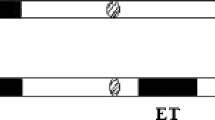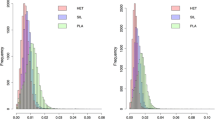Abstract
In April 1978 a total of 26565 drosophilid flies were collected in Egypt. Of ten species five are new records for Egypt, while two previously reported Drosophila species were not found. Seven of the species belong to the genus Drosophila and are known to be partly, or wholly, domestic.
For the first time Drosophila subobscura is reported from Egypt. The species was collected at low frequency in an orchard near Alexandria, and one specimen was trapped in a city park in Cairo. Judged from the gene arrangements of 41 males studied, Egyptian Drosophila subobscura seem likely to be derived from recent immigrants from the south coast of Asia Minor.
Similar content being viewed by others
References
Becker Th., 1903. Aegyptische Dipteren. Mitt. zool. Mus. Berl. 2: 1–195.
Burla H., 1951. Systematik, Verbreitung und Oekologie der Drosophila-Arten der Schweiz. Rev. suisse Zool. 58: 23–175.
Butzer K. W., 1959. Studien zum vor-und frühgeschichtlichen Landschaftswandel der Sahara. III. Die Naturlandschaft Aegyptens während der Vorgeschichte und der dynastischen Zeit. Abh. math.-naturw. Kl. Akad. Wiss. Mainz 1959 (2): 43–122.
Gat J. R. & Magaritz M., 1980. Climatic variations in the eastern Mediterranean Sea area. Naturwissenschaften 67: 80–87.
Goldschmidt E., 1956. Chromosomal polymorphism in a population of Drosophila subobscura from Israel. J. Genet. 54: 474–496.
Goldschmidt E., 1958. Polymorphism and coadaptation in natural populations of Drosophila subobscura. Proc. X. int. Congr. Ent. 2: 821–828.
Götz W., 1965. Chromosomaler Polymorphismus in einem Muster von Drosophila subobscura aus Marokko, mit Darstellung der Heterozygotieverhältnisse als Heterozygotiediagramme. Z. indukt. Abstamm.-u. VererbLehre 97: 40–45.
Götz W., 1967. Untersuchungen über den chromosomalen Strukturpolymorphismus in kleinasiatischen und persischen Populationen von Drosophila subobscura Coll. Molec. gen. Genet. 100: 1–38.
Jungen H., 1968. Inversionspolymorphismus in tunesischen Populationen von Drosophila subobscura Collin. Arch. Julius Klaus-Stift. VererbForsch. 43: 3–54.
Krimbas C. B., 1967. The genetics of Drosophila subobscura populations. III. Inversion polymorphism and climatic factors. Molec. gen. Genet. 99: 133–150.
Krimbas C. B. & Alevizos V., 1973. The genetics of Drosophila subobscura populations. IV. Further data on inversion polymorphism in Greece — Evidence of microdifferentiation. Egypt. J. Genet. Cytol. 2: 121–132.
Levins R., 1968. Evolution in changing environments. Princeton Univ. Press, Princeton, N. J., 120 pp.
Malogolowkin-Cohen, C. & Sperlich, D., 1981. The effect of isolation and marginality on the inversion polymorphism of Drosophila subobscura in Israel. Revta bras. Genet.
Mourad A. M. & Mallah G. S., 1960. Chromosomal polymorphism in Egyptian populations of Drosophila melanogaster. Evolution 14: 166–170.
Nicholson S. E. & Flohn H., 1980. African environmental and climatic changes and the general atmospheric circulation in late Pleistocene and Holocene. Climat. Change 2: 313–348.
Pipkin S. B., 1952. Seasonal fluctuations in Drosophila populations at different altitudes in the Lebanon mountains. Z. indukt. Abstamm.-u. VererbLehre 84: 270–305.
Prevosti A., 1974. Chromosomal inversion polymorphism in the southwestern range of Drosophila subobscura distribution area. Genetica 45: 111–124.
Rognon P., 1976. Essai d'interprétation des variations climatiques au Sahara depuis 40 000 ans. Revue Géogr. phys. Géol. dyn. 18: 251–282.
Shorrocks B., 1977. An ecological classification of European Drosophila species. Oecologia 26: 335–345.
Tantawy A. O., 1964. Studies on natural populations of Drosophila. III. Morphological and genetic differences of wing length in Drosophila melanogaster and D. simulans in relation to season. Evolution 18: 560–570.
Tantawy A. O. & El-Helw M. R., 1970. Studies on natural populations of Drosophila. XII. Heterosis and fitness characters in hybrids between different populations of Drosophila melanogaster. Can. J. Genet. Cytol. 12: 695–710.
Tantawy A. O. & Mallah G. S., 1961. Studies on natural populations of Drosophila. I. Heat resistance and geographical variation in Drosophila melanogaster and D. simulans. Evolution 15: 1–14.
Tantawy A. O., Mourad A. M. & Masri A. M., 1970. Studies on natural populations of Drosophila. VIII. A note on the directional changes over a long period of time in the structure of Drosophila near Alexandria, Egypt. Am. Nat. 104: 105–109.
Timoféeff-Ressovsky N. W., 1935. Ueber geographische Temperaturrassen bei Drosophila funebris F. Arch. Naturgesch. N. F. 4: 245–257.
Author information
Authors and Affiliations
Rights and permissions
About this article
Cite this article
Bächli, G., Burla, H. & Jungen, H. Drosophila subobscura in Egypt and its probable derivation. Genetica 59, 3–7 (1982). https://doi.org/10.1007/BF00130809
Received:
Accepted:
Issue Date:
DOI: https://doi.org/10.1007/BF00130809




